In this guide, we’ll unpack:
- When clawbacks actually work (and when they backfire).
- The most common clawback models.
- What motivates and demotivates reps, what finance needs, and how to build a structure that keeps everyone on track toward the same goals.
- Real-world examples with payout math and recovery tables you can use to inform your compensation planning process.
- How to automate the difficult parts with a tool like Drivetrain.
Imagine it. Your sales team just landed a big new logo—the kind of deal that really lifts the quarter. The rep celebrates, the CRO gives a shoutout in Slack, and finance approves the commission payout.
Then, three months later, the customer cancels and refunds hit.
This is exactly where a well-structured clawback policy saves the day, giving finance a clear, defensible way to recover commission and protect margins.
Without one, you’re stuck making awkward calls, patching over gaps, and watching your CAC balloon on deals that never should’ve paid out.
And while clawback clauses can help correct course, they’re often treated as a last resort or worse, implemented in ways that quietly erode trust and reps’ morale.
This article breaks down how to use clawbacks in a way that motivates sellers to close better deals with best-fit customers so everyone wins.
We’ll show you how clawbacks actually work, the mechanics behind each model, and how to design them without wrecking your sales team’s trust. You’ll get side-by-side examples with the payout math, and learn about the trade-offs associated with each clawback model so you can pick one that fits your organization and goals, not someone else’s template.
And if you’re trying to align sales incentives with long-term retention without triggering a standoff with sales leadership over clawbacks, you’re in the right place.
What is a clawback clause and why is it important?
A clawback clause is a contractual agreement that allows a company to recover previously paid commissions if certain conditions aren’t met. Clawbacks clauses are used by many different types of businesses to ensure that sales reps are not just closing deals but the right deals.
If your company pays commissions to your sales reps, you probably need a clawback clause in your sales rep agreement.
Think of it as a pressure-release valve for performance pay. Without it, you risk over-rewarding short-term wins that fail to deliver on the promised growth. With it, you’re aligning sales incentives with the value those sales bring to the business.
Structured correctly, clawback clauses in sales rep agreements:
- Align commission with earned, not projected value
- Give finance teams a clear path to recover overpayments
- Prevent margin erosion
- Helps you stay compliant with ASC 606
When are clawbacks triggered?
- Customer non-payment: The contract is signed, but the customer never pays.
- Early cancellation or refund: The customer churns within the first 30–90 days.
- Product return or service opt-out: The service is cancelled or returned mid-cycle.
- Revenue reclassification or scope change: A customer downgrades or cancels part of the scope after signing.
- Fraud or rep’s misrepresentation: A sales rep materially misleads the customer or internal stakeholders to win a deal by overpromising features, falsifying documentation, or gaming eligibility.
Across these scenarios, the role of clawbacks is simple: Restore balance between what’s earned and what’s paid, not by punishing sales reps, but by defending your revenue integrity.
The strategic role of clawbacks in sales compensation
Clawbacks aren’t just about recovering money. They’re how high-performing finance teams design compensation plans that protect your business, your books, and your brand before deals go sideways.
A well-designed clawback clause helps you to do that in six different ways.
Ties commissions to net revenue, not just bookings/sales
Without clawbacks, you’re recognizing commission as a cost before the corresponding revenue is fully earned. That inflates your CAC, distorts your expense ratios, and makes payback periods look cleaner than they are. Clawbacks help fix that by anchoring payouts to realized revenue, not signed contracts.
Protects gross margin from early churn and failed onboarding
The margin damage from a deal that doesn’t deliver—the customer doesn’t accept delivery of the product or service—isn’t just lost revenue, it’s locked-in commission and wasted time. Of course, you can’t get that time back, but with a clawback clause, you can reverse at least part of that loss and keep your margin profile intact.
Eliminates shadow accounting and commission disputes
Shadow accounting—the practice of maintaining parallel accounting records alongside the company’s official records—is not uncommon for sales reps in companies with complex commission plans. This is often driven by a lack of transparency (real or perceived) in the company’s system for tracking commissions and/or just a need to make it simpler to understand.
In either case, clawbacks that aren’t clearly defined can lead to commission disputes that can take a lot of time to resolve. A well-structured clause gives you a clear and enforceable path to recover overpayments, without the awkward Slack threads or last-minute comp plan rewrites to fix something that could have been made clear in the first place.
Prevents perverse incentives that inflate short-term wins
When reps are rewarded solely on bookings, you risk a flood of poor-fit customers who never take delivery of the product or service. This is true for any kind of business but is particularly damaging for SaaS companies where long-term growth is dependent on revenue retention through contract renewals.
Clawbacks nudge reps to qualify harder and sell for deals that last. Take HubSpot for example. In a LinkedIn post, Daphne Costa Lopes, HubSpot's Global Director of Customer Success for Strategic Accounts described the benefits the company witnessed after introducing its clawback policy:

Supports ASC 606 compliance
Under ASC 606, you’re required to match commission expense to revenue that’s probable and collectible.
If a customer churns early and that revenue gets reversed, the corresponding commission needs to come off the books as well.
A clawback clause makes that adjustment defensible in audits and board reviews.
Provides legal protection
Without clawback language, you’re locked into the payout, even if the deal falls apart for reasons outside your control, such as misrepresentation or regulatory disputes.
Clear clawback terms give you legal and operational leverage in those edge cases.
The hidden costs of a poorly designed clawback policy
Clawbacks provide some pretty powerful benefits. However, if not designed well, they can also backfire operationally, financially, and culturally. Here are some important things to keep in mind when you’re designing your clawback policy.
Sales demotivation and lack of trust
When clawbacks feel punitive or arbitrary, they break the trust between the sales rep and the company. Instead of reinforcing accountability, they can be highly demotivating, triggering frustration and defensiveness on the part of your sales reps.
In the worst cases, they can result in bad behaviors, such as reps holding back pipeline, sandbagging deals, or disengaging from CS handoffs altogether.
All of this translates to slower sales cycles, weaker forecasts, and a talent retention problem you can’t model your way out of.
Shadow accounting = higher administrative overhead
When your sales reps don’t trust the company’s compensation structure, they build their own: tracking their earnings in spreadsheets, questioning payroll calculations, and escalating disputes to finance.
Complexity and lack of transparency in commission structure adds a lot of administrative overhead. Clawbacks that rely on manual reconciliation or subjective enforcement become a black hole for RevOps and Finance. Every refund triggers a Slack thread. Every dispute becomes a fire drill.
If your sales reps are using shadow accounting, it’s a clear signal that something is broken—they either do not understand the compensation model and/or do not trust your system for tracking their commissions.
Misaligned incentives create churn loops
If your clawback policy is designed around deal mechanics (like ARR thresholds) but ignores customer success signals, it won’t solve the problem of canceled contracts and churn—it will just shift the blame.
Clawbacks should fix the root cause: short-term selling that leads to long-term leakage. If not, you’re just masking the real issue with penalties that won’t change behavior.
Legal and compliance risks escalate
Without clearly documented clawback language in your offer letters and compensation plans, enforcement can be a risky business. Sales reps can challenge clawbacks post-payout, especially in jurisdictions with strict labor laws.
And in the absence of consistent application, your policy can be seen as discriminatory—or worse, unenforceable. That’s not just a legal issue. It’s a governance red flag.
The takeaway here...
A clawback policy is only as effective as the clarity, fairness, and operational ease it delivers.
Build it reactively, and you’ll spend more time defending it than benefiting from it.
Design it strategically, and it becomes one of your sharpest levers for aligning revenue, retention, and sales rep behavior.
6 types of clawback clauses with examples
Here, we offer examples of six different types of clawbacks. To make these easier to follow, we’ll use the same example compensation plan and performance data for each of our clawback examples.
Here’s our example compensation plan:
- Timeframe: Quarterly quota period
- Base commission: 10% of ARR earned for deals within quota (Tier 1)
- Accelerated commission: 25% on ARR exceeding quota (Tier 2)
- Rep's quarterly quota: $325,000
Here is the sales rep's performance data for Period 1:
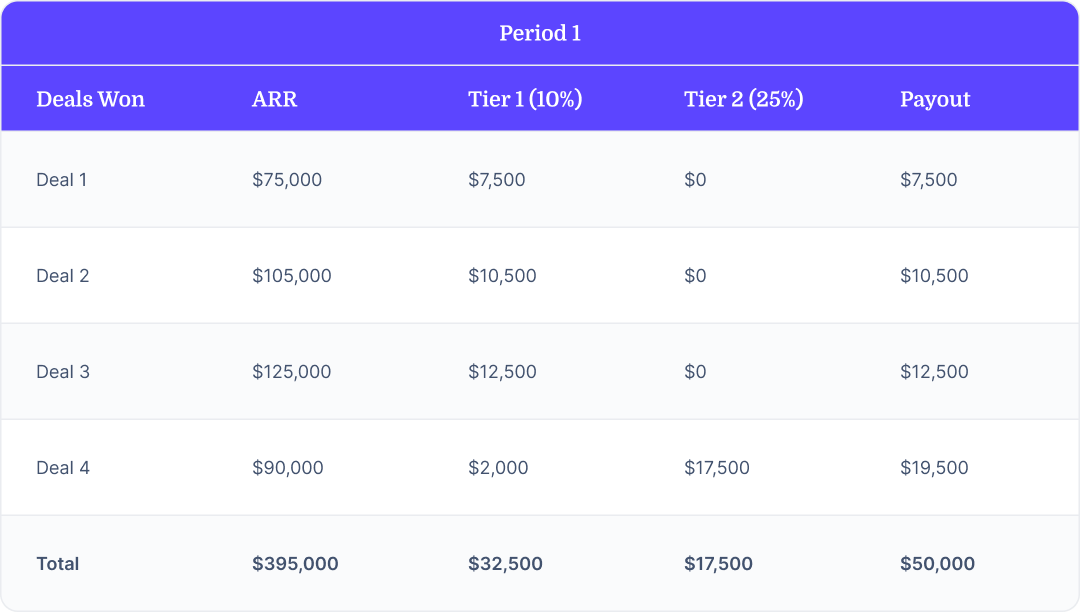
Note that the rep hits the quota with Deal 4. The first three deals add up to $305,000. So, for Deal 4, rep’s Tier 1 (base commission) of 10% applies only to the first $20,000 of the deal’s ARR (the amount needed to hit quota). The remaining $70,000 in ARR is paid out at the 25% Tier 2 commission ($17,500).
Now, here’s the sales rep's performance data for Period 2, which will be used in each example to illustrate how the clawback is calculated:
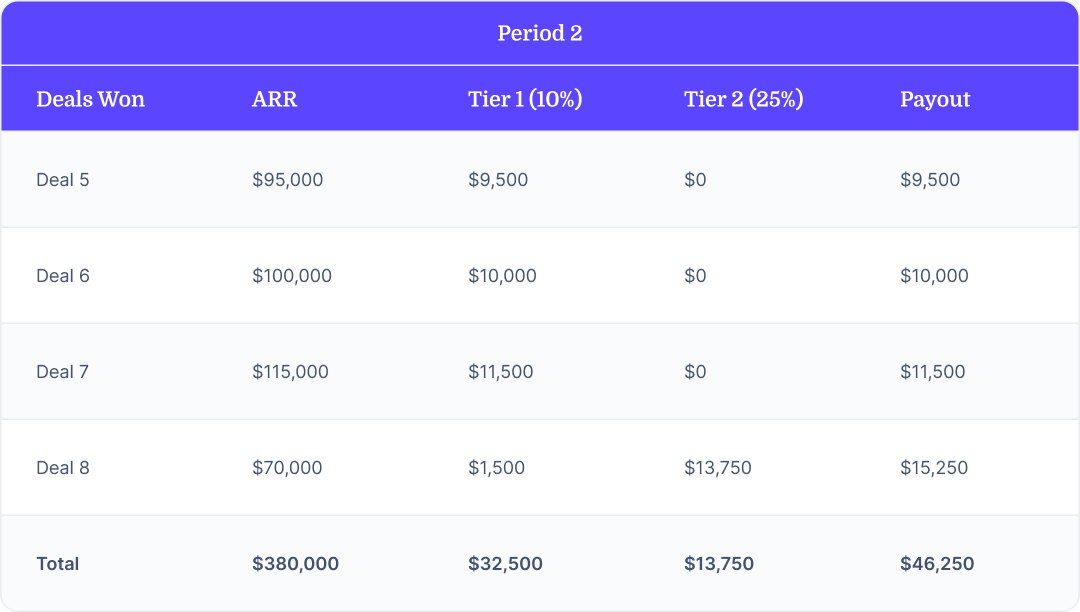
In Period 2, the rep hits the quota with Deal 8. The first three deals add up to $310,000. For Deal 8, the rep’s base commission) applies only to the first $15,000 of the deal’s ARR, and the remaining $55,000 in ARR is paid out at the 25% Tier 2 commission ($13,750).
Now let's see what happens when Deal 4, which resulted in a payout of $19,500 to the sales reps, completely falls through.
1. Commission-only clawback
Definition: A commission-only clawback recovers only the commission paid, without adjusting quota attainment or ARR calculations.
This is probably the most straightforward approach of all the examples we cover here.
The rep's quota attainment for both periods stays exactly as calculated, but the $19,500 commission paid for Deal 4 gets recovered as a negative line item in Period 2.
Think of it like returning a purchase to a store. The transaction happened, but the money came back.
The Period 2 commissions add up to $49,625. The $19,500 clawback from Deal 4 is simply subtracted from that, reducing the payout in Period 2 to $30,125.
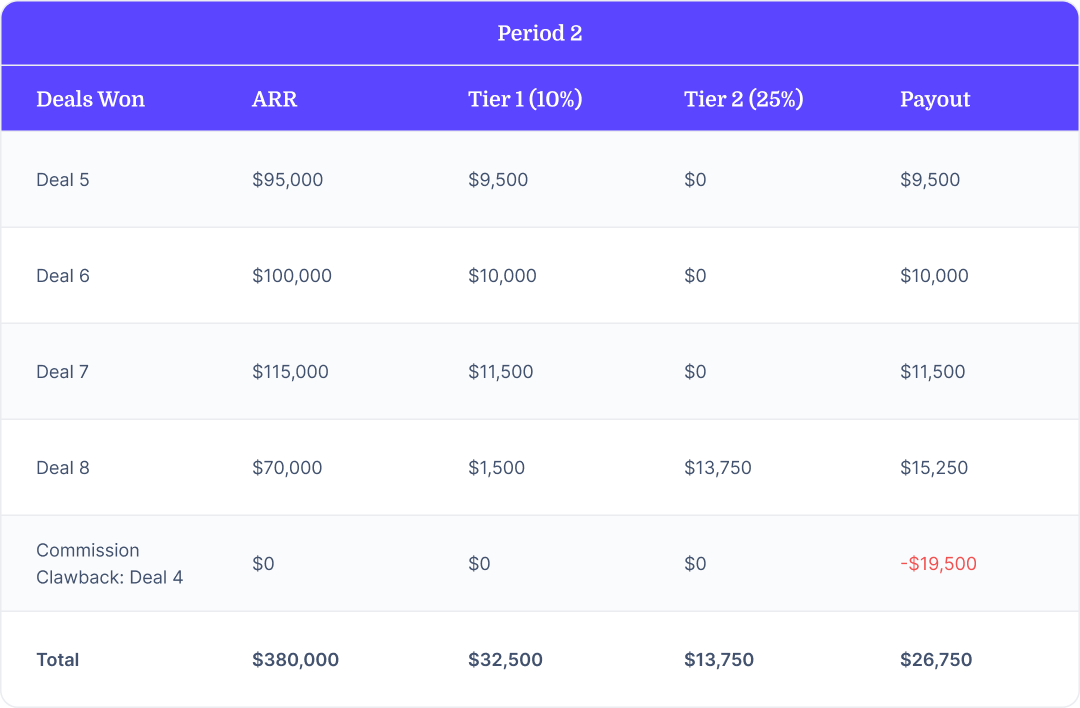
From the sales rep’s perspective
Benefits:
- Simple to understand and track
- Quota achievement stays intact for Period 1
- No impact on accelerator tiers or future quota calculations
- Historical performance metrics remain unchanged
Drawbacks:
- Sudden, significant income hit in the period when clawback occurs
- Can feel punitive if the deal failure wasn't the rep's fault
- No consideration for partial value delivered
- May create cash flow problems if the rep has already spent the commission
From the company’s perspective
Benefits:
- Operationally simple to implement and track
- Clean separation between quota achievement and commission recovery
- Easy to audit and explain to stakeholders
- Immediate cost recovery
Drawbacks:
- Doesn't reflect the true impact on business performance
- May seem unfair to reps, potentially damaging morale
- Ignores the quota inflation that the failed deal created
- Can create tension if applied inconsistently
2. Negative quota credit (current or future period)
Definition: A negative quota credit applied retroactively is a clawback that removes the failed deal from the original period's quota attainment, as if it never happened.
A negative quota credit clawback applied in the current or future period treats the failed deal as negative ARR against the current period's quota attainment.
Instead of clawing back the full commission, you’re adjusting the Period 2 performance as if $90,000 in revenue vanished from their pipeline.
With the $90,000 loss applied as negative ARR in Period 2, the rep’s total ARR drops to $290,000 which is below the rep’s $325,000 quota.
Keeping in mind the tiered commission structure, all the Period 2 deals are now paid out at the base 10% rate, and $9,000 of the commission tied to Deal 4 is clawed back. Instead of the original $46,250 payout the rep would have received for Period 2, payout is $37,250.
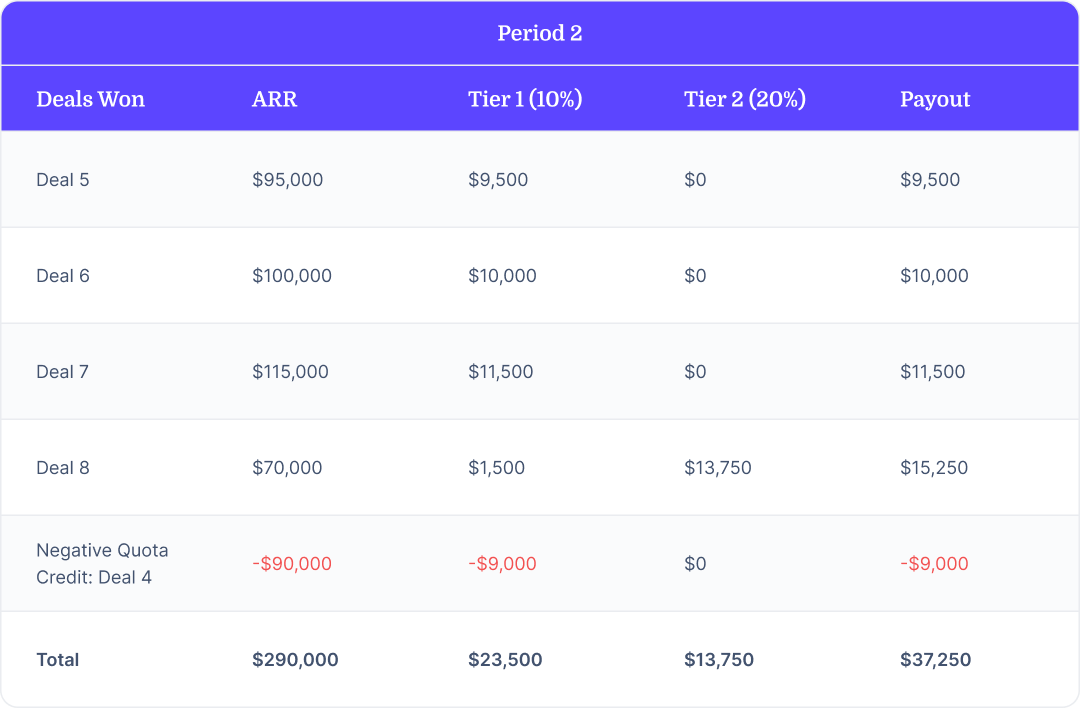
From the sales rep’s perspective
Benefits:
- Smaller immediate financial impact ($9,000 vs the full $19,500)
- Feels more proportionate to the actual loss
- Maintains a logical connection between performance and pay
- Less severe cash flow disruption
Drawbacks:
- Loses Tier 2 acceleration benefits in the current period
- Can feel like punishment for someone else's failure
- May not reflect the actual timeline of when value was delivered
- Quota attainment metrics become harder to interpret
From the company’s perspective
Benefits:
- Better reflects true business impact
- Aligns commission expense with actual revenue recognition
- Provides more accurate performance metrics
- Easier to justify from a fairness standpoint
Drawbacks:
- More complex to calculate and track
- Requires sophisticated compensation management systems
- May not fully recover the financial impact of the failed deal
- Can create confusion about quota attainment reporting
3. Negative quota credit (retroactive)
Definition: A negative quota credit applied retroactively is a clawback that removes the failed deal from the original period's quota attainment, as if it never happened.
Unlike the previous clawback type, this approach "rewrites history" by removing Deal 4 from Period 1 entirely. We recalculate the rep's original period performance, quota attainment, and commission as if the deal never existed.
Here’s how it plays out:
Deal 4 is retroactively removed from Period 1 as if it never existed. The rep’s total ARR for that quarter falls from $395,000 to $305,000, pulling them below quota. With no ARR exceeding the threshold, all earnings revert to the base 10% rate, and the entire $19,500 commission tied to Deal 4 is clawed back. The rep’s payout for Period 1 gets restated as $30,500, down from $50,000 as shown in the table below.
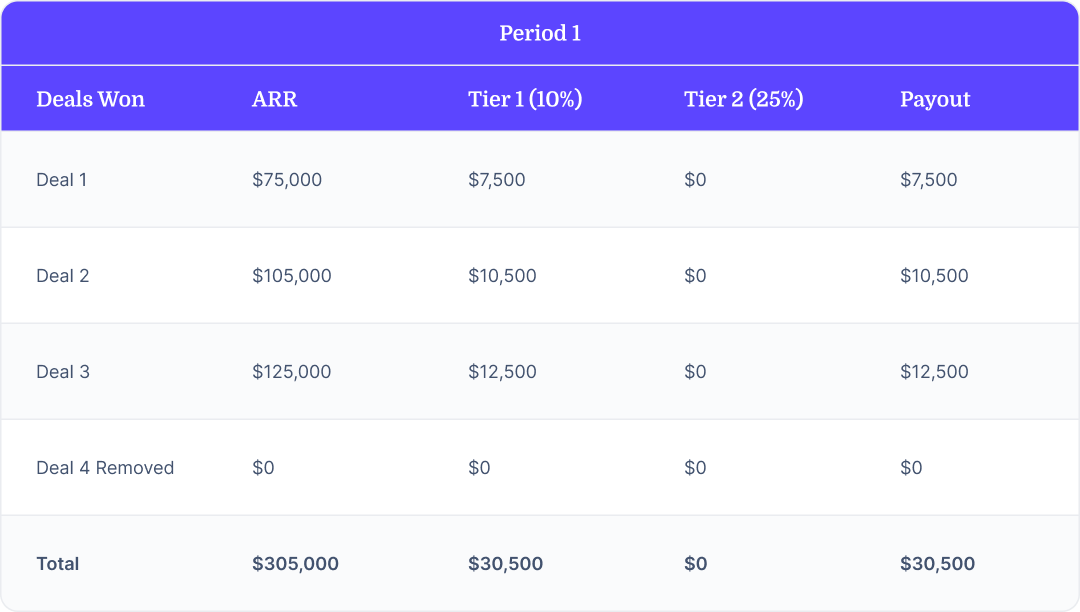
While this type of clawback changes the record for the period in which the original deal was made, the actual clawback usually happens in the period immediately following. It appears as a negative commission entry in the amount of the original commission. In our example, Period 1 this would be a negative entry in Period 2 of $19,500.
From the sales rep’s perspective
Benefits:
- Maintains logical consistency with actual business results
- No surprise negative items in current period statements
- Clear connection between deal failure and commission adjustment
- Preserves the principle that commission reflects real value delivered
Drawbacks:
- Feels like "rewriting history" which can create distrust
- May impact previously calculated bonuses or recognition
- Can affect historical performance comparisons
- Creates confusion about what actually happened in past periods
From the company's perspective
Benefits:
- Provides the most accurate historical performance data
- Ensures commission expense matches actual revenue
- Cleaner for financial reporting and ASC 606 compliance
- Eliminates inflated quota attainment metrics
Drawbacks:
- Complex to implement and explain
- May require restating financial reports
- Can create legal complications if not clearly documented
- Difficult to audit and track changes over time
4. Pro-rata clawback
Definition: A pro-rata clawback recovers commission proportionally based on how much value the customer actually received.
Now, let’s imagine a deal where value was partially delivered. In this scenario, the customer for Deal 4 used the product for three out of twelve contracted months before canceling.
That’s 25% of the contract fulfilled and paid for. Instead of clawing back the full commission, the company applies a pro-rata clawback.
The rep keeps 25% of the original payout and returns the remaining 75%. In this case, the rep returns $14,625 of the original $19,500.


From the sales rep’s perspective
Benefits:
- Feels fair because it reflects actual value delivered
- Recognizes the rep's role in securing the initial contract
- Reduces the financial impact compared to full clawback
- Maintains incentive to close deals even if long-term retention is uncertain
Drawbacks:
- Still creates unexpected income reduction
- Requires trust in the company's calculation of "value delivered"
- May not account for implementation effort that didn't lead to adoption
- Can be subjective depending on how "usage" is defined
From the company's perspective
Benefits:
- Balances fairness with financial protection
- Easier to gain rep buy-in compared to full clawback
- Reflects the principle that partial value deserves partial compensation
- Provides flexibility for different churn scenarios
Drawbacks:
- Requires precise tracking of customer usage and payments
- More complex to calculate and administer
- May not fully recover the margin impact of failed deals
- Can create disputes about how to measure "value delivered"
5. Conditional clawback
Definition: A conditional clawback is a type of clawback that gets triggered only when specific, predetermined conditions are met.
Now let’s say the customer cancels early, but this time, the commission plan includes a clear condition: “If the customer churns within 90 days, the rep forfeits the full commission.” This is what’s called a conditional clawback. Unlike the pro-rata model, it doesn’t matter how much of the product was used, it cares just whether the trigger condition was met.
Because the cancellation happened inside the 90-day window, the entire $19,500 tied to Deal 4 gets clawed back in Period 2. The rep’s payout drops from $46,250 to $26,750.
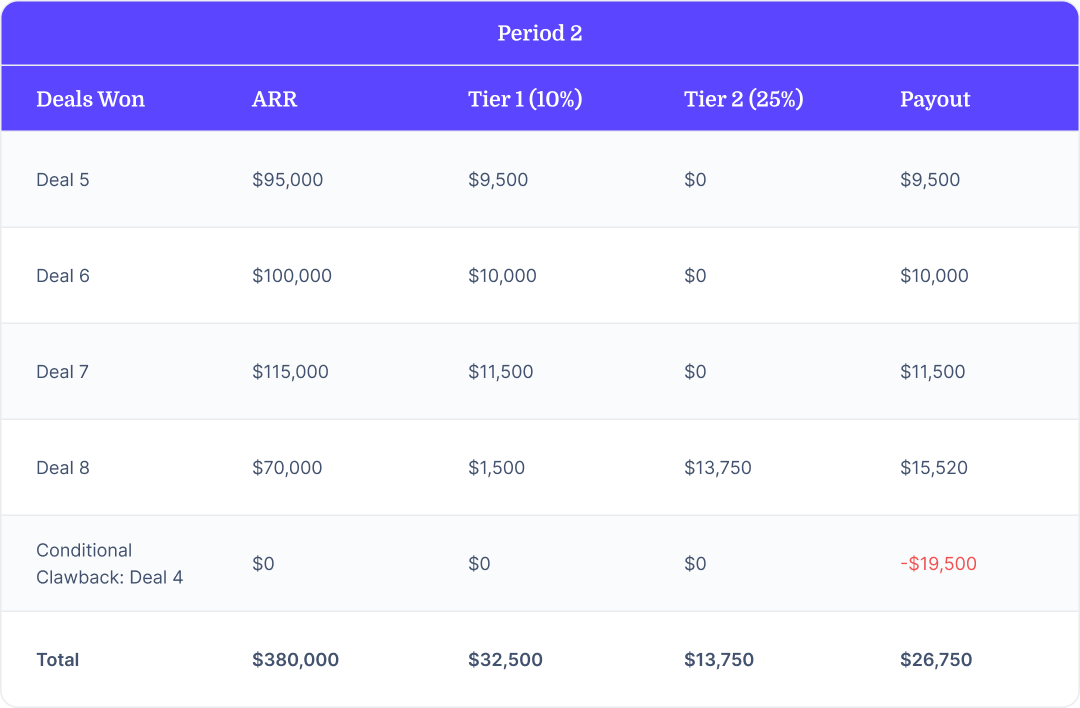
From the sales rep’s perspective
Benefits:
- Clear, unambiguous rules that everyone understands upfront
- No surprises about when clawbacks apply
- Incentivizes better qualification and customer fit assessment
- Easier to plan around because conditions are predetermined
Drawbacks:
- Can feel arbitrary, especially if conditions are narrow
- May not reflect actual value delivered or effort invested
- Creates pressure to avoid certain deal types or customer segments
- Can trigger "all or nothing" thinking that reduces risk-taking
From the company’s perspective
Benefits:
- Simple to implement and enforce
- Clear accountability for deal quality
- Encourages reps to focus on retention indicators
- Provides consistent treatment across all deals
Drawbacks:
- May not accurately reflect business impact
- Could discourage reps from pursuing legitimate but risky opportunities
- Requires careful condition setting to avoid unintended consequences
- Can create compliance challenges if conditions are too restrictive
6. Future period clawback
Definition: A future period clawback is one in which the clawback is treated as a recoverable debt the sales reps owes the company.
This type of clawback is a little different conceptually from the other types of clawbacks we discussed here. In all of our previous examples, the clawback is taken in one lump sum.
With the future period clawback, the company instead, treats it like a recoverable debt, gradually offset against future commissions the rep earns. Think of it like a payment plan: no big hit upfront, but you’re working off the debt, deal by deal. This softens the financial blow to the sales rep but stretches the payback period across multiple quarters.
In our example, there wouldn’t be an immediate deduction in Period 2. However, the sales rep would pay back the $19,500 clawback through withholding of the commissions for Period 3 ($8,000), Period 4 ($7,500), and Period 5 ($4,000 of the total $6,000 in commission). Instead of taking home the total commission of $21,000 earned Periods 3-5, the rep receives a payout of $2,000.
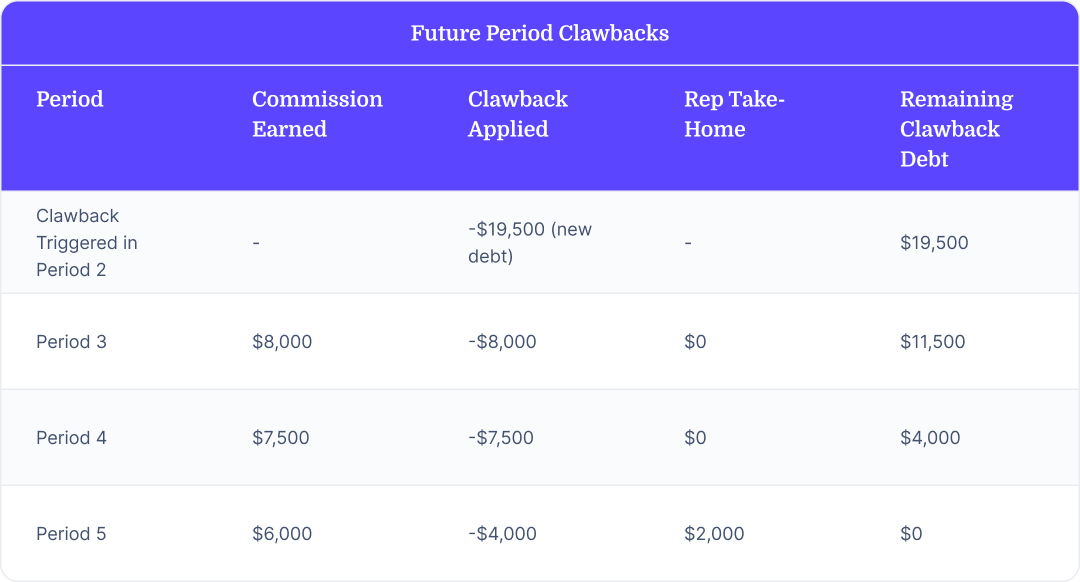
From the sales rep’s perspective
Benefits:
- Spreads financial impact across multiple periods
- Avoids sudden, severe cash flow disruption
- Allows time to recover through new sales performance
- Less psychologically damaging than immediate large clawback
Drawbacks:
- Creates ongoing uncertainty about actual take-home pay
- May reduce motivation if future earnings are consistently reduced
- Can feel like being "punished" repeatedly for the same mistake
- Difficult to plan personal finances around variable payouts
From the company’s perspective
Benefits:
- Reduces rep turnover that might result from severe immediate clawbacks
- Maintains sales team stability during challenging periods
- Provides flexibility for high-value deals that fail
- Can preserve relationships with high-performing reps
Drawbacks:
- May never fully recover the money if rep leaves or underperforms
- Creates ongoing administrative complexity
- Harder to forecast and budget commission expenses
- Can create inequitable treatment if applied inconsistently
Choosing the right clawback structure
The best clawback method depends on your specific business context, sales cycle, and company culture.
Remember: The goal isn't just to recover money. It's to align incentives, maintain trust, and build a sustainable compensation structure that works for everyone.
The best clawback policy is one that reps understand, finance can implement, and leadership can defend. That balance is what separates companies that use clawbacks as a strategic tool from those that treat them as a necessary evil.
Understanding perverse incentives in sales commissions
Ideally, a compensation plan would benefit both the company and its sales reps. However, if not designed well, the plan can create what economists call a perverse incentive.
Perverse incentives occur when compensation structures inadvertently encourage behaviors that are counterproductive to the company's long-term goals.
Here are a few signs that indicate your compensation plan may be creating a perverse incentive:
- Your sales reps are working on leads that are barely qualified and/or pushing deeply discounted SKUs.
- There seems to be an overemphasis on logo count at the expense of high-LTV, right-fit customers.
We all know that incentives shape behavior. When it comes to sales, Drivetrain’s CEO, Alok Goel considers the potential impact of incentives as behavioral economics in action:
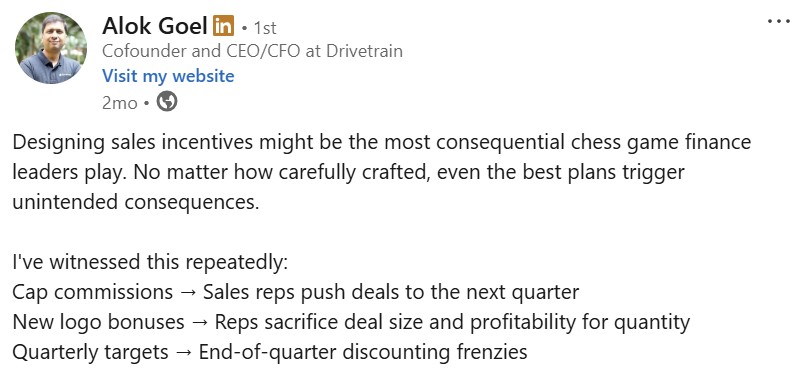
How to spot the blind spots before they hurt?
Goel recommends using AI to help you evaluate your incentive plan in terms of its potential to inadvertently incentivize negative sales behaviors.
Upload your draft compensation plan into an AI assistant and run this exact prompt:
Review this sales incentive plan as both a behavioral economist and an experienced sales leader and answer the following questions:
- What unintended behaviors might this plan encourage?
- Where might reps game the system?
- What kind of deals will they chase or avoid?
- What risks does this create for revenue, margin, or retention?”
Using the results you get from this prompt, engage in deeper conversations with your sales leaders about predicted behaviors and potential safeguards you could build in to avoid them. Doing this before you implement your incentive plan can prevent months of misaligned selling behavior and thousands in unrecoverable commissions.
Mitigation strategies that work
- Set retention or activation gates before commission is fully vested.
- Tie part of the comp to usage.
- Run scenario modeling to see how edge cases might distort payout logic.
- Layer in clawbacks as a backstop, not as a punishment, but as a quality filter.
How Drivetrain helps you enforce clawbacks without friction
We’ve unpacked the what, why, and how of clawbacks and the risks of getting them wrong. Now it’s time to translate policy into practice.
Clawbacks only work when they’re more than words in a comp plan. They need visibility, automation, and buy-in across Finance, Sales, and RevOps.
Drivetrain makes that possible.
As a connected planning platform built for modern finance teams, Drivetrain gives you the infrastructure to roll out clawbacks that are fair, auditable, and effective, without the spreadsheet gymnastics.
Here’s how:
- Track commissions against realized revenue, not just bookings
Sync your HRIS, CRM, and billing data to ensure commissions are validated against what’s actually been earned, not just what was signed. If revenue is reclassified or canceled, you’ll see it (and claw it back) automatically. - Flag clawback triggers in real time
No more chasing churned deals in quarterly audits. Drivetrain surfaces red flags like non-payment, early cancellation, or refunds the moment they hit your systems, so Finance can act fast and decisively. - Model and compare multiple clawback structures
Want to test commission-only clawbacks versus negative quota credits? Curious how a 90-day conditional window impacts top performers? Run side-by-side scenarios before rolling anything out and pick the model that fits your margin strategy. - Give sales reps transparency and managers talking points
With shared dashboards and sales rep-level breakdowns, you can show—not just tell—how clawbacks work. That builds trust and cuts down on commission disputes, back-and-forths, and shadow accounting. - Support ASC 606 compliance with defensible audit trails
Every commission earned. Every dollar clawed back. Every trigger logged. Drivetrain keeps your records clean and audit-ready, whether you’re reporting to the board or prepping for a financial review.
Ready to roll out clawbacks the right way? Check out Drivetrain!
Frequently asked questions
No. Some U.S. states (like California) have strict rules around wage deductions, which may affect how clawbacks can be enforced. Always consult legal counsel when drafting these provisions.
Implementing a clawback policy cannot completely prevent perverse incentives. Clawbacks should be considered as one part of a broader incentive strategy that includes activation milestones, churn metrics, and scenario-tested compensation plans.
It is considered a best practice to structure payouts in batches. For example, 50% at deal close and 50% after 90 days of customer usage. This balances motivation with caution.
Using a comprehensive financial planning and analysis (FP&A) platform like Drivetrain will help you syncs performance, payout, and customer success data in real time to track clawbacks. Avoid relying on disconnected spreadsheets or manual workflows.
Clarity is key. Make sure reps understand what triggers a clawback and how to avoid them. Consider layering in retention-based bonuses to reinforce sustainable selling.

.svg)






.webp)



.svg)

